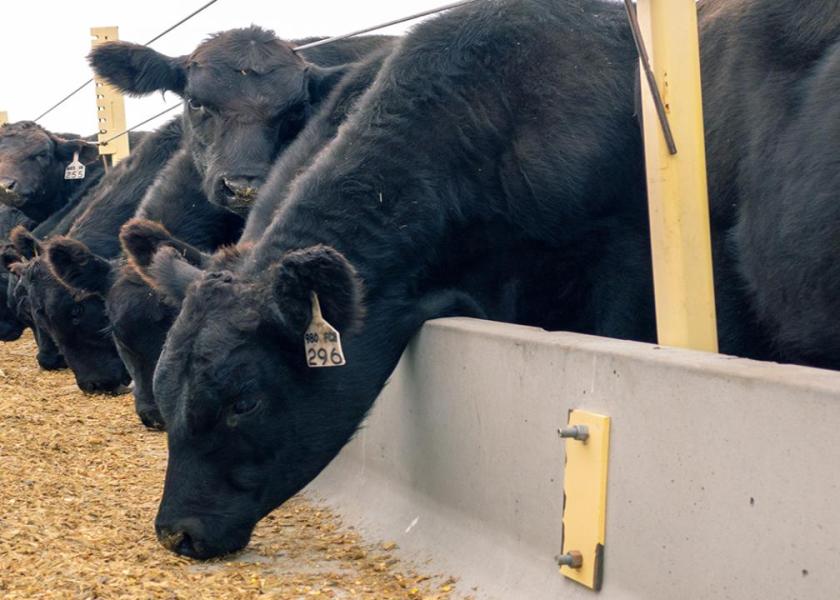Preconditioning Calves: Is It the Right Choice?

Fall weather is here, and it brings the start of weaning for many producers. Weaning is a stressful time, not only for the producers, but also for calves. Many changes occur in these young animals’ lives. They are separated from mom and the supply of milk they have grown accustomed to, and they are often moved to an unfamiliar location. There are ways to make weaning a less-stressful time for all involved. There are low-stress weaning methods, such as fence line and two-step weaning. View our Low-Stress Weaning Methods article to learn more about these methods.
Preconditioning involves weaning calves at least 45 days in preparation to enter the stocker phase or directly into the feedlot. During this time, calves are started on dry feed or “bunk broke.” Additionally, this time allows a producer to build the health status of calves through vaccinations, deworming and getting them over the stressful time of weaning without adding additional stressors, such as co-mingling or transport. Preconditioning is an option for producers looking to retain ownership or to sell their calves.
Nutrition During Preconditioning
A target average daily gain of 2 to 2.5 pounds per day should be the focus to prepare these calves for the feed yard. To achieve this goal, a variety of feeds can be fed to calves at the beginning of the preconditioning phase.
The combination will vary greatly depending on the ranch feeding these calves. It is important to provide good-quality feed that is palatable and nutrient dense. Calves will have reduced intakes following weaning; thus, the diet needs to provide enough energy and protein, even when consumed at lower amounts. High palatability will encourage calves to eat. Intake will begin to increase as calves adjust to the new environment.
A balance between roughage, such as grass hay, and easily fermented feeds, like corn, needs to be achieved to prevent incidences of acidosis and other digestive issues that can impact calf performance. Ionophores can be utilized within these diets. Have a conversation with a local livestock nutritionist or your area’s extension agent about developing the proper diets for preconditioning calves that best fit your operation’s needs.
Benefits
Preconditioning has benefits for those looking to sell their calves and to those retaining ownership. On average, preconditioning can cost the producer $35 to $60 dollars per head.1 This number is subject to change due to a variety of factors; however, this is a general cost to expect. The increase in input cost can result in a premium received at the sale barn. These premiums are variable. Previous research indicates a range of $3 to $5 per hundredweight (abbreviated as cwt), but premiums of as high as $8 per cwt have been reported.2
Promotion of calf growth and improved health status are benefits both to the producer retaining ownership and to a buyer purchasing cattle for placement in a feedlot. Researchers in Texas3 evaluated feedlot closeouts and found that calves that had been preconditioned for 45 days or longer had:
- 7.2 % improved feed efficiency
- $29.47 per head lower medicine cost
- 3.1 % lower death loss
Oklahoma researchers4 found that preconditioned calves had a 22.4 and 2.9 percent lower morbidity and death loss respectively when compared to calves with little to no health management history.
Considerations
Preconditioning is not a “one size fits all” for operations. The benefits need to be considered along with practicality. Questions producers need to ask themselves include:
- Do I have the pasture or pen space to keep calves an extra 45 days or more?
- What does my feed availability look like?
- Can my facilities handle bunk breaking calves? Do I have the equipment available?
- Can I handle the increase in labor and the extra time commitment?
- Can I handle the extra costs that come with preconditioning?
Depending on the answers to these questions, preconditioning may be an economical option for a producer. A review done by F. A. Thrift5 found that return on preconditioned calves sold ranged from -$89.92 to $53.71 per calf. The decision should not be taken lightly and should be discussed thoroughly to evaluate the pros and cons that may be experienced. The seasonal patterns of the cattle market and price slides on heavier calves also need to be included in the conversation in deciding if preconditioning is something to include in your program.
The Bottom Line
Preconditioning is not a one size fits all program. Producers need to find the preconditioning program that best fits their operation. This includes examining labor needs, vaccination costs, feed availability, and space. There are many preconditioning programs that are certified at the sale barn. Sale barns and video auction platforms have different ways of reporting vaccination and preconditioning status. Talk with your local sale barn or video auction provider to determine the process they follow or if they offer a special preconditioned calf sale.
Additionally, building rapport with buyers by providing high-quality calves may result in return buyers more willing to pay higher prices knowing the level of care that goes into the animals. As always, consult with your local veterinarian to determine the best vaccines to utilize for your herd and geographical area.
Literature Cited
1. Lalman, D. and Mourer, G. (2017). Effects of Preconditioning on Health, Performance and Prices of Weaned Calves. Oklahoma State University Extension. ANSI-3529.
2. Donnell, J., Ward, W., Swigert, S. (2007). Costs and Benefits Associated with Preconditioning Calves. Oklahoma State University Extension. AGEC-247.
3. Cravey, M. (1996). Preconditioning effect on feedlot performance. Proc. Southwest Nutrition and Management Conference, Phoenix, AZ, 33–37.
4. Lalman, D., Hutson, S., Shearhart, W., Ward, C., & McKinley, S. (2005). Preconditioning reduces sickness and death loss in weaned calves. Journal of Animal Science, 83 (Suppl. 2), 21.
5. Thrift FA, Thrift TA (2011). Update on preconditioning beef calves prior to sale by cow-calf producers. Prof Anim Sci 2011; 27:73-82.







